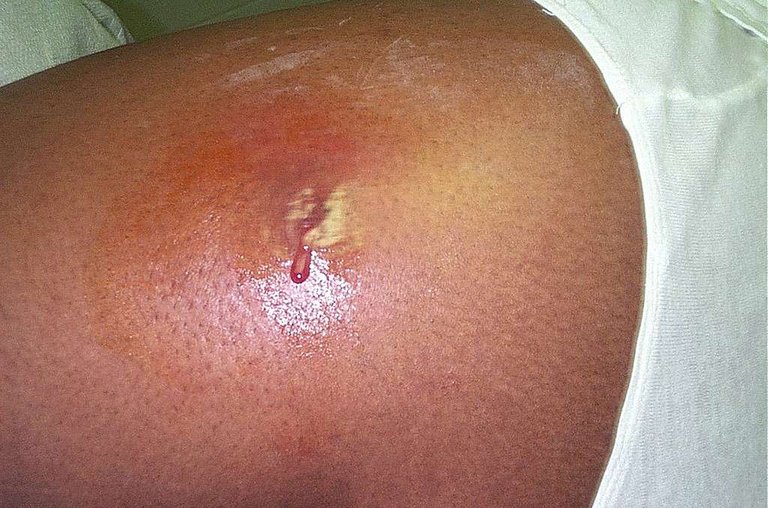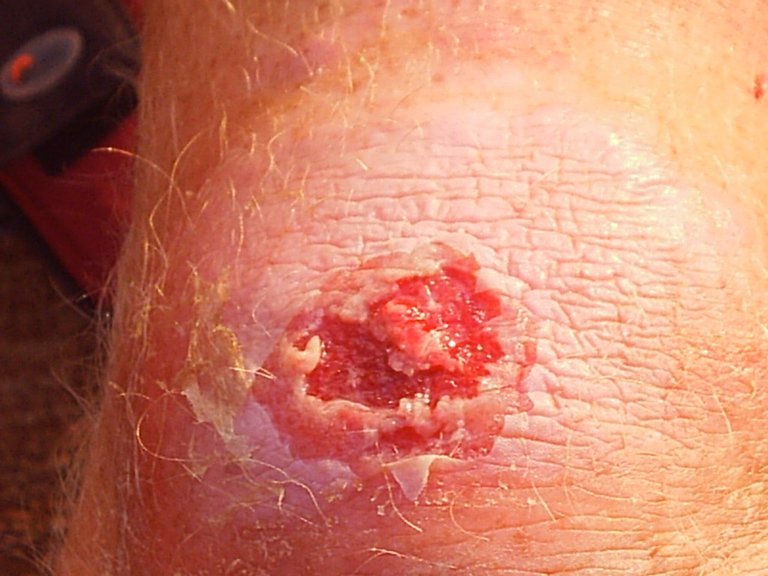There was a trending video of a woman who was crying so hard on the internet because she had lost her child to staphylococcus, there were different questions about how this happened, and all she kept saying was that parents need to be careful about the visitors they permit into their homes.
As a Mum, I knew this was a topic I had to read more about and know how to protect my Son appropriately. Let's explore staphylococcus infection as a topic friends, and even more about how it can affect children.

picryl.com
Staphylococcal infections, commonly known as staph infections, are caused by a bacterial genus known as Staphylococcus, with different strains amounting to up to 30 different types, the most common human pathogen is Staphylococcus aureus.
Staphylococcal bacteria could cause different types of infections, we have the likes of;
Skin infections, which are often the most common type, include bone infections, food poisoning, pneumonia, toxic shock syndrome (TSS), endocarditis, and Bacteremia.
There is a possibility of carrying staph bacteria on the skin or in the nose, and not having an infection. However, when there is a cut or a wound, the bacteria can enter deep into the body, into the bloodstream, lungs, joints, bones, heart, and lungs, thereby causing a situation of life-threatening staph infections.
Staph bacteria can spread from one person to another, they can also spread on objects like; clothes, door handles, towels, equipment, remote controls, and a lot more.
Simply put, treating a case like this would be with the use of antibiotics and cleaning of the area affected. However, in some cases, staph infections no longer respond or they even become resistant to simple antibiotics.
Staph infection may have the resemblance of boils or pimples, it may be swollen, red, and painful. Sometimes, it comes with pus or other drainage. Remember that, the symptoms of staph infection depend on the type of infection. So, a case of bone infection would attract symptoms of pain, warmth, swelling, chills, fever, and redness in the affected area.

flickr.com
Toxic shock syndrome (TSS) causes sudden low blood pressure, vomiting, confusion, diarrhea, and high fever. TSS can also result in organ failure.
A situation of food poisoning would cause vomiting, diarrhea, fever, and nausea. The loss of excessive fluid would make you dehydrated. If pneumonia is the case, there would be an experience of chest pain, shortness of breath, chills, and high fever that does not seem to get better over time.
Now, let's get to the one that significantly affects children a lot, Methicillin-resistant Staphylococcus aureus (MRA), this type of staphylococcus aureus (MRSA) and cannot be killed with common staph antibiotics, and it is often limited to the skin. They can be life-threatening when they get spread to the bloodstream, the lungs, or other organs. It is usually more difficult to treat than other staph bacteria, but other oral and IV antibiotics can successfully treat it, it is easier to get this done if it is discovered on time.
Children usually have several germs on their skin and nasal passages, just like adults, and it wouldn't cause any problems at all. However, MRSA can cause an infection if the skin of the child gets cut or scratched, and remember they do not have a strong immune system so it could be either a small or even multiple blisters that would spread into the bloodstream creating severe issues.
MRSA was discovered first in hospitals and nursing homes, but as more people carry it in their nasal passages, there is a higher risk of the infection spreading the more. A child can pick up MRSA when he or she comes in contact with a person with MRSA on the skin, touching a surface where there is MRSA, touching the wound of a person who has MRSA Infection, being close to a person with MRSA sneezing or coughing.
MRA is more common amongst groups of people who spend time together, and it may transfer due to an injury whilst playing. The symptoms of MRSA in children are; bumps that appear under the skin and are firm or swollen, the skin around a sore that is hot or warm, a painful bump that is red, swollen, or leaking fluid, a rash or blister filled with fluid.
A case of systematic infection comes with an addition of sleepiness, dizziness or fainting, chills, fever, and serious headache. In this case, instant treatment is required, so take the affected child to a certified doctor.
To diagnose the child, a physical examination would be carried out, and other tests like; a skin swab, cultures of samples of blood, spit, or fluid, an x-ray of the lungs to check if the lungs are not infected, echocardiogram of the heart to check if the heart is infected, and CT scan or MRI, to ascertain if other tissues, joints, or bones are infected.
Treating MRSA would depend on the symptoms felt by your child, the age, and general health. If it is a case of mild MRSA skin infection, it would most likely be treated through the opening of the infected sore and draining out the fluid. Sometimes, a prescribed antibiotic ointment or antibiotic medicine by mouth.
Many infections can be cured within a week, but others may take longer time if left unattended, a case of MRSA skin infection may cause damage to other nearby tissues, turn into an infection that would then spread all through the body, infect other people through physical contact or contact with contaminated items.
You can help protect your child by ensuring that he or she shes her hands often if they are of age, and wash your own hands as well, this would stop all kinds of infections from spreading. In the absence of soap and water, make use of hand sanitizer. Keep bandages on wounds, sustain sores and cuts covered clean until there is healing.
Do not allow your children to scratch their kin too much, this could create breaks in the skin where bacteria can penetrate, if required, get an anti-itch cream.Tell your children not to share personal items like their towel.
Care must be taken upon a visit to the health center, family houses, or daycares. Regularly disinfecting everything a child touches is very necessary.
For Further Studies.
https://www.ncbi.nlm.nih.gov/pmc/articles/PMC8630804/
https://medlineplus.gov/staphylococcalinfections.html
https://www.mayoclinic.org/diseases-conditions/staph-infections/symptoms-causes/syc-20356221
https://www.rch.org.au/kidsinfo/fact_sheets/staphylococcal_infections/

Hi, I am Tobi, a writer, speaker, relationship blogger, and lover of good music. I love making friends and learning from people. If you want to hear me speak on relationships and general life issues, you can find my YouTube channel where you can watch any episode for free, please do not forget to subscribe, friends. I sincerely appreciate every love I get from here, Kindly do well to keep them coming.
